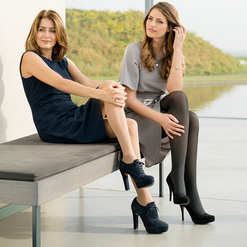Support, compression or anti-thrombosis stockings?
When do I have to wear medical compression stockings? What is the difference between support and compression stockings? We give you the answers.
Support stockings should not be confused with compression stockings. They are suitable only for those with healthy veins - as a preventive measure against heavy, tired legs after standing or sitting for a long period of time and also against travel thrombosis. As these products serve a preventive purpose, their cost is not borne by sickness fund and they cannot in the case of venous disease be a substitute for compression stockings either.
Support stockings such as Gilofa
- Are a preventive measure for those with healthy veins
- Are against tired, heavy legs when forced to stand or sit for long periods of time
- Have a lower level of pressure than med. compression stockings (below comp. class I)
- Support stockings are not tested according to RAL GZ 387
- Size is not based on individual measurements but on shoe size or clothes size
- Are not prescribed by a physician
- Aickness fund does not assume the cost for support stockings
- Available as standard products
- Only manufactured as round-knitted products
- Should not be worn if venous disease exists
Medical compression stockings
Medical compression stockings are manufactured in a standardised process in four different compression classes that differ from each other by the level of pressure applied in the ankle area. At least in Europe this process is standardized and subject to quality control, for example, in conformity with German RAL Quality Assurance GZ 387/1 for medical stockings.
Medical compression stockings are considered to be the basic treatment for all types of venous and lymphatic vessel disease. They apply precisely defined pressure on tissue and vessels. Distended veins are pressed together to their normal diameter, venous valves not yet destroyed close again and perform their function as reflux valves. Blood can flow unimpeded back to the heart and no longer accumulates in the legs. Medical compression stockings are most effective when the patient moves about.
Medical compression stockings such as Memory
- Can be prescribed by a physician (prescribable)
- Are measured
- Precisely defined pressure
- In conformity with RAL Quality Assurance GZ 387/1 for medical stockings
- Four compression classes (significantly higher level of pressure than support stockings)
- For the treatment of the venous and the lymphatic vessel system
- Available as standard or made-to-measure products
- Sickness funds in most cases bear the cost of compression treatment
- Round and flat knitted compression stockings
Anti-thrombosis stockings
For thrombosis prevention in the case of bedridden patients medical compression stockings are never used, as they do not become totally effective unless the patient moves about. Anti-thrombosis stockings are therefore not compression stockings!
The stockings are used in hospitals and nursing homes in the case of bedridden and post-operative patients as preventive care against thrombosis. Because of their low pressure and the knitting method used, they are not suitable for patients who sit or move about. For recognition purposes anti-thrombosis stockings are only knitted in white.
Anti-thrombosis stockings
- Are not a compression stocking or a support stocking
- Are only for bedridden patients in hospitals or nursing homes
- Have too little pressure for patients who sit or move about
- Are not tested in accordance with RAL GZ 387
- Have less pressure than compression class 1
- Are only available as standard products
- Are only available in white
- As a rule white thigh length stockings with an open toe or an inspection hole under the ball of the foot

